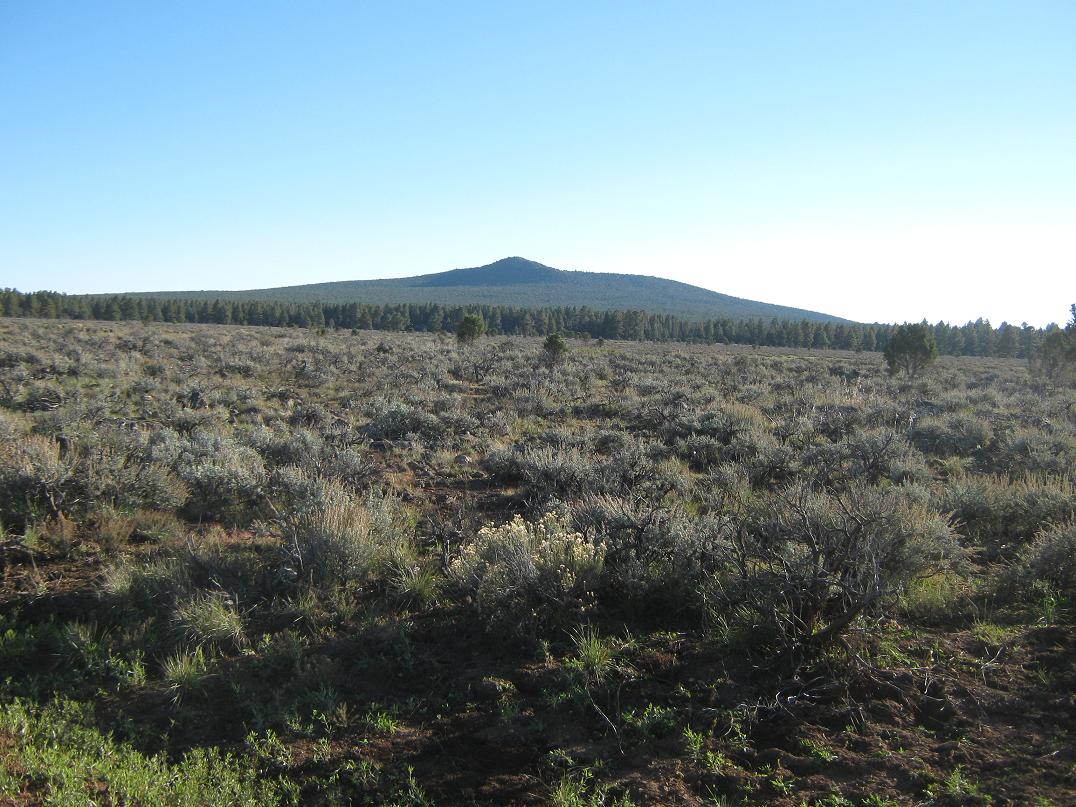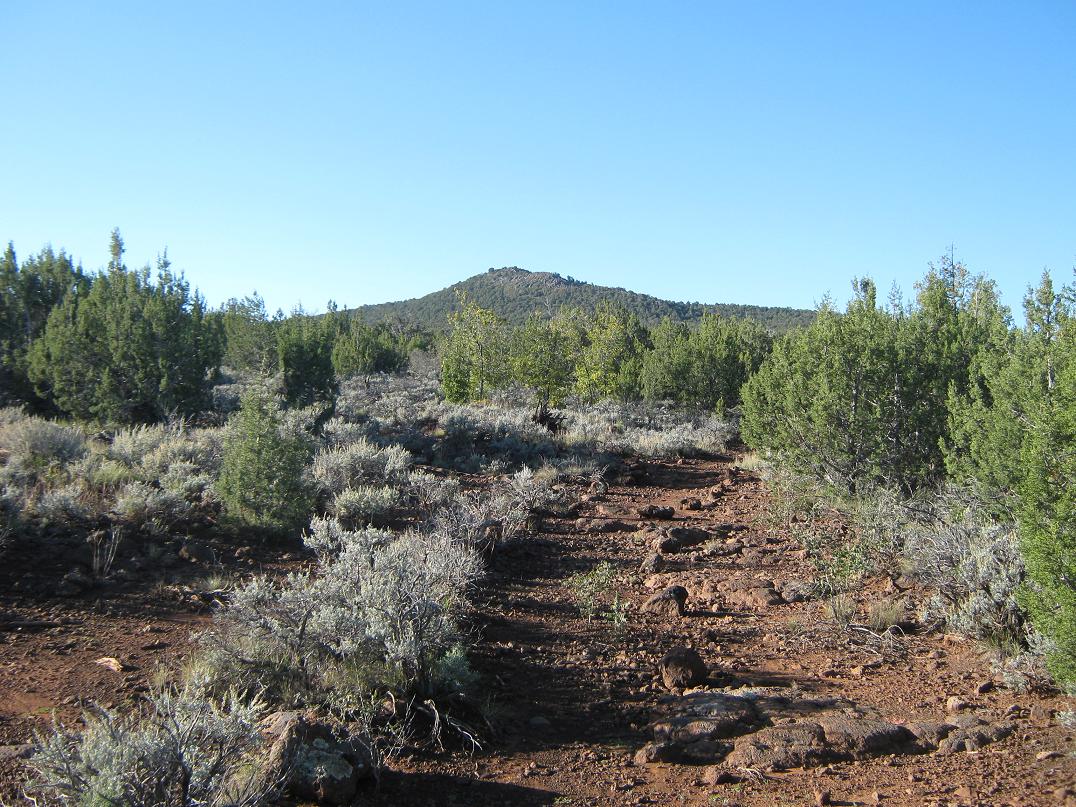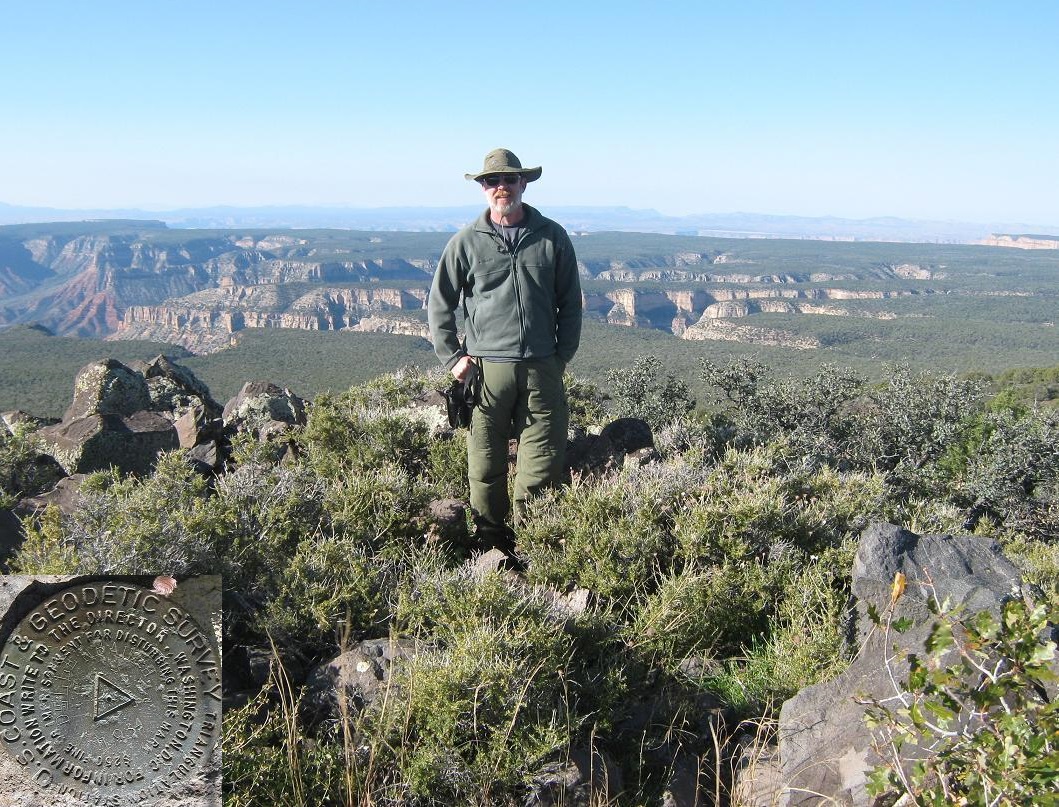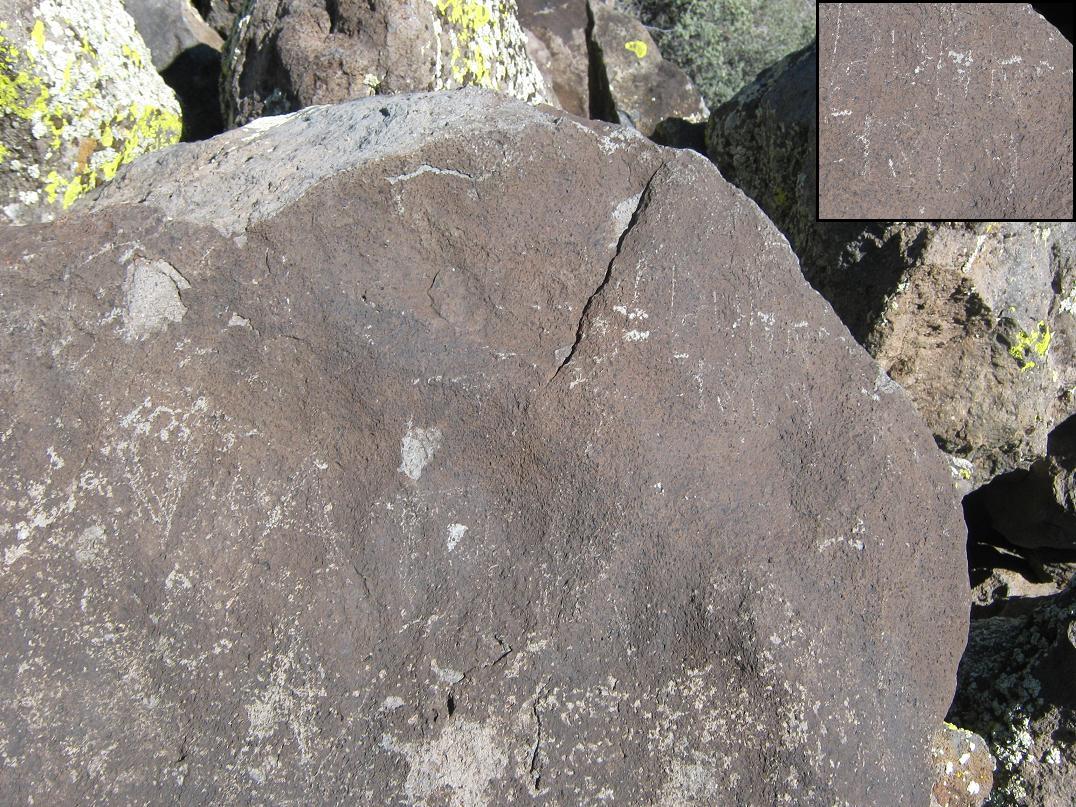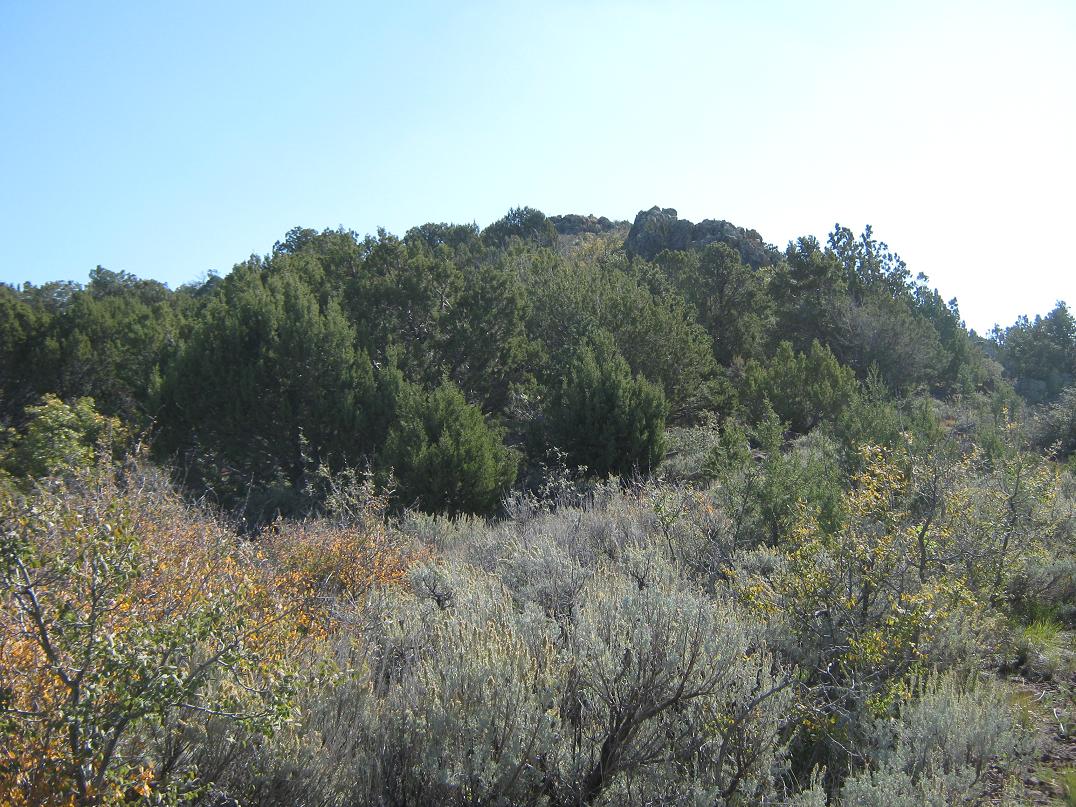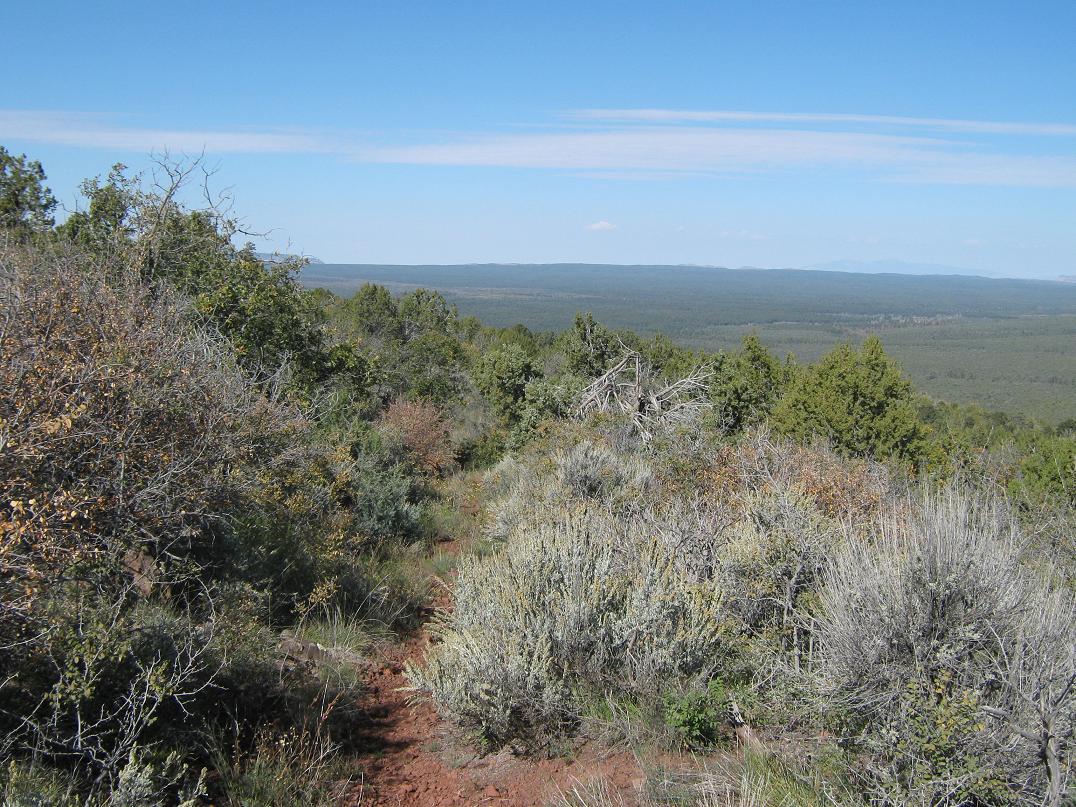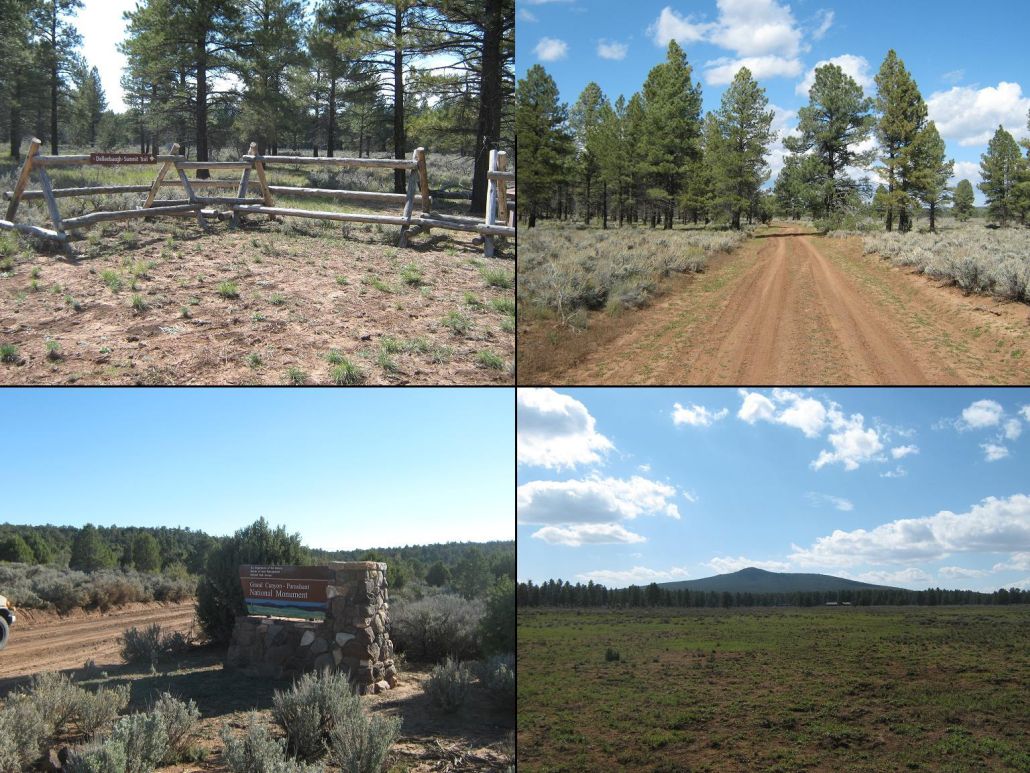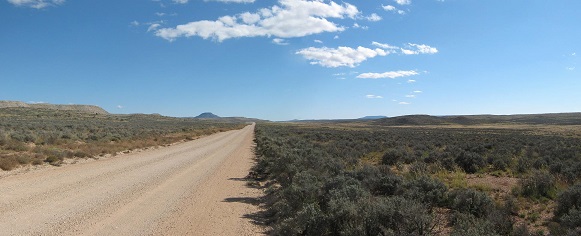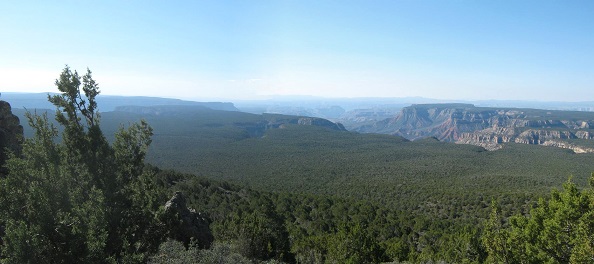
The Mountains of Arizona
• www.surgent.net
|
| Mount Dellenbaugh |
• Shivwits Plateau, Arizona Strip • Highpoint: Lake Mead National Recreational Area • Mohave County |
|
Date: October 13, 2013
• Elevation: 7,072 feet
• Prominence: 1,752 feet
• Distance: 4 miles
• Time: 4 hours
• Gain: 900 feet
• Conditions: Clear with steady breezes
• Teammates: Scott Casterlin
Mount Dellenbaugh is on the Shivwits Plateau in northwest Arizona, on the remote Arizona Strip. The closest paved road is 90 miles to the north in St. George, Utah. The peak is shield formed by ancient volcanism, more broad than high, with consistent and gentle slopes all around it. It is covered in ponderosa pine and pinon-juniper woodland, and an old jeep road, now closed and reworked as a trail, allows easy access to the summit.
Assuming one does not mind nearly 90 miles of dirt-road driving to get to the trailhead, a hike up Mount Dellenbaugh is straightforward and a moderate workout. The reward is the amazing views of the expansive Arizona Strip to the west, north and east, and the mighty side canyons that adjoin the Grand Canyon to the south. The peak is named for Frederick Dellenbaugh, a painter and photographer who was part of Major John Wesley Powell's 1871 expedition to the Grand Canyon. However, the peak is notable for its role, so to speak, in Powell's 1869 exploration of the region.
In 1869, Powell and nine other men, a motley collection of mountain men, former Civil War veterans and "greenhorns", sought to be the first people ever to float down the Colorado River through the Grand Canyon, thus exploring and mapping the last great unknown (as in unmapped) place in the United States. The expedition set out from Green River, Wyoming, in May of 1869. The trip was extremely difficult and taxing. A couple men bailed early. The rest hung in there, but struggled daily with the unknown river.
In late August, three of Powell's men, brothers Oramel and Seneca Howland, and William Dunn, abandoned the expedition and hiked north through Separation Canyon and onto the Shivwits Plateau, this hike itself a notable feat. They then scaled this peak to gather their bearings. While there, William Dunn etched his name and year into a rock near the summit. The three men then continued north toward St. George, but were killed, supposedly by the Shivwits Indians, but possibly by radicalized Mormons who lived in the area. The real truth may never be known. Just two days later, Powell and his remaining crew emerged from the Grand Canyon, succeeding in their quest.
I encourage anyone reading this to follow up with any of a number of well-written historical accounts of the expedition, and not rely on my two-paragraph summary. It is a fascinating story, underscoring just what these explorers were up against at that time.
Since that time, the Arizona Strip has not changed much. It is the section of Arizona north of the Grand Canyon and south of Utah. Most of it is undeveloped rangeland, high-desert with sage meadows, and tracts of ponderosa pine forest and juniper-pinon woodland. Ranching and timber were the main uses of this land back in the early days, and although the land was outside the territory of Utah's boundaries, it was essentially an unofficial extension of Utah, with St. George the jump-off point into this region. Arizonans south of the Grand Canyon at that time would have had to make a long journey around the canyon to get to the Strip, assuming they wanted to. Even today, only two bridges span the canyon within Arizona, both up near Page where the Canyon is not as gigantic and a bridge can feasibly be built. Today, most of the land is managed by the BLM, a lot of it contained within the Grand Canyon-Parashant National Monument. The Grand Canyon National Park and the Lake Mead National Recreational Area manage much of the rest.
By comparison, the Casterlin-Surgent expedition of 2013 would be much tamer than Powell's. It was supposed to be a larger group but people dropped out until just two hardy souls hung in there. Scott drove, and I was shotgun. We left Friday afternoon the 11th, and made the long drive through Las Vegas and Mesquite, camping that night in the desert near Littlefield, Arizona. The next day, we visited a confluence and then drove into St. George for last-minute supplies and gas. We then embarked south and onto the Strip, entering at River Road off of the Southern Parkway south of St. George.
The first dozen or so miles, the road is through low-desert scrubland, but then the road gains steeply and achieves the north end of the Shivwits Plateau. We followed the main road (BLM-1069) another 7 or 8 miles to come to a junction near the ghost town of Wolf Hole, and the junction with BLM-1004. Here, we took a break and ate lunch, then took a couple hours out to drive and hike to the top of Wolf Hole Mountain, one of the many plateau-peaks that lie atop the Shivwits. Essentially, all of this land is a series of plateaus, little ones on bigger ones, with the Shivwits being the main western plateau of the Strip (The Kaibab Plateau is the main eastern plateau).
We were done with Wolf Hole Mountain by 12:30, so we continued south on BLM-1069, now marked as Mohave County Road 5. The junction with Road 103, leading to Mount Dellenbaugh, was another dozen miles to the south. The remoteness and "bigness" of the land up here is truly stunning, sometimes hard to comprehend as even in most places in the desert, there's always some hint of man, such as relic buildings, power lines, things like that. Here, there's nothing other than the roads and the occasional BLM signs. The scale is very big, and I tried to capture it in panorama photographs such as the one below.
We followed Roads 5 and 103 south and southwest, taking the roads slowly and covering the remaining 50 miles in about 3 hours. The road passes through forest and rolling hills, then emerges into wide open meadows, the tone of the landscape changing subtly and consistently as we travelled south. Interestingly, Mount Dellenbaugh itself is not obvious until about a dozen miles north of it. In time, we had arrived into the area, arriving about 4 p.m., the last few miles within old-growth ponderosa pine forest. We found a good camping pullout about a mile south of the trailhead, and hunkered in for the evening. The weather was mild and mostly still, but we were at about 6,000 feet elevation, so the temperatures would still dip into the 30s by early morning.
We were up with the Sun the next morning and after about an hour of standing around and warming up, we broke camp, loaded the vehicle and drove to the trailhead. This is a newer trailhead, meant to shuttle people away from the Grand Canyon-Parashant administrative center buildings where the old "trailhead" (old road) was located. We were hiking around 7:30 a.m..
The first mile of the hike is along a meandering trail through the ponderosa, with small sage meadows. In time, the ponderosa gave way to the pinon and juniper, and we met with the old jeep road, now following that for the two miles southwest toward the peak. We moved efficiently and arrived at the end of the road in a little over an hour, a 900-foot gain. The final 40 vertical feet was up easy rock slope to the rocky summit, where we were met with a very stiff wind. The views were remarkable! Below is a panorama of the view to the northeast.
The view west and south was even more impressive:
And so was the south view:
The real challenge lay ahead of us: locating William Dunn's 1869 inscription on one of the summit-area rocks. Scott had directions from a previous visitor, but the directions were misleading (whether deliberately or not, we don't know). The directions to these etchings are never publically disseminated, to protect them from vandals. I won't be giving any specifics here, either.
We set out to find these etchings and spent the better part of an hour looking at every rock for these elusive marks. The directions we had sent us on a wild goose chase, seemingly pointing us in a direction that seemed implausible. We looked and looked and looked with no luck. At one point, I gave up and sat for about 20 minutes near some rocks, thinking that it was not meant to be.
Scott really wanted to find these etchings: they were a primary goal for him for this trip. Finally, we abandoned the directions and thought, "where would an explorer from 1869 naturally carve in his name and year?" So we went to where we thought would be a plausible spot, and by gum, I found them! The marks were badly faded and not obvious at all. Even standing a couple feet away, they are barely visible and only if the light is at a good angle. In fact, we had walked right past this rock at least once each earlier. It was thrilling to locate these etchings, a real tangible connection to a long-ago piece of history. It really was like finding a needle in a haystack.
Our true objective complete, we walked back down the trail and to Scott's vehicle, arriving there a little before noon. We took our time in changing clothes and relaxing, before starting the long drive out, now heading east toward tomorrow's intended hike, Mount Logan. As circumstances would happen, we hiked Logan late this afternoon.
It was a pleasure to visit, hike and find those old etchings on Mount Dellenbaugh. Thanks to Scott for driving and also being persistent in the search for these etchings. This is a beautiful area and I hope that future visitors take care of it as we tried to do in our time there.
|
|
